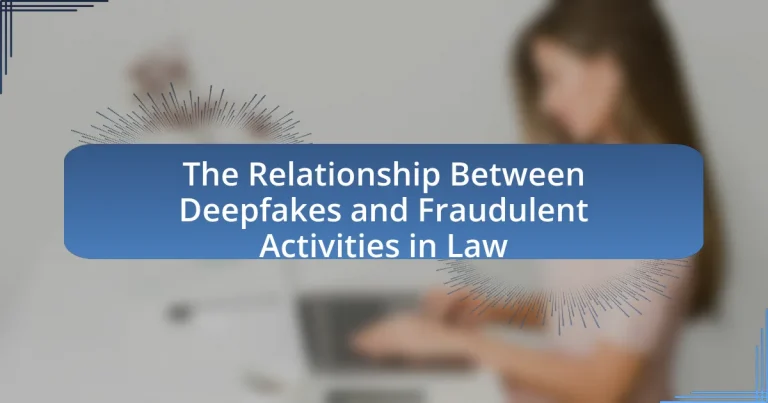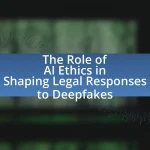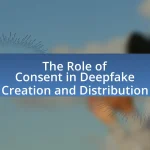Deepfakes are AI-generated synthetic media that can manipulate audio and video to create realistic but false content, posing significant challenges in legal contexts. This article explores the relationship between deepfakes and fraudulent activities, highlighting their potential use in scams, identity theft, and defamation cases. It discusses how deepfakes are created using advanced technologies, the types of fraud they facilitate, and the implications for evidence integrity in court. Additionally, the article examines existing legal frameworks, the challenges they face, and the importance of understanding deepfakes for legal professionals to combat fraud effectively.
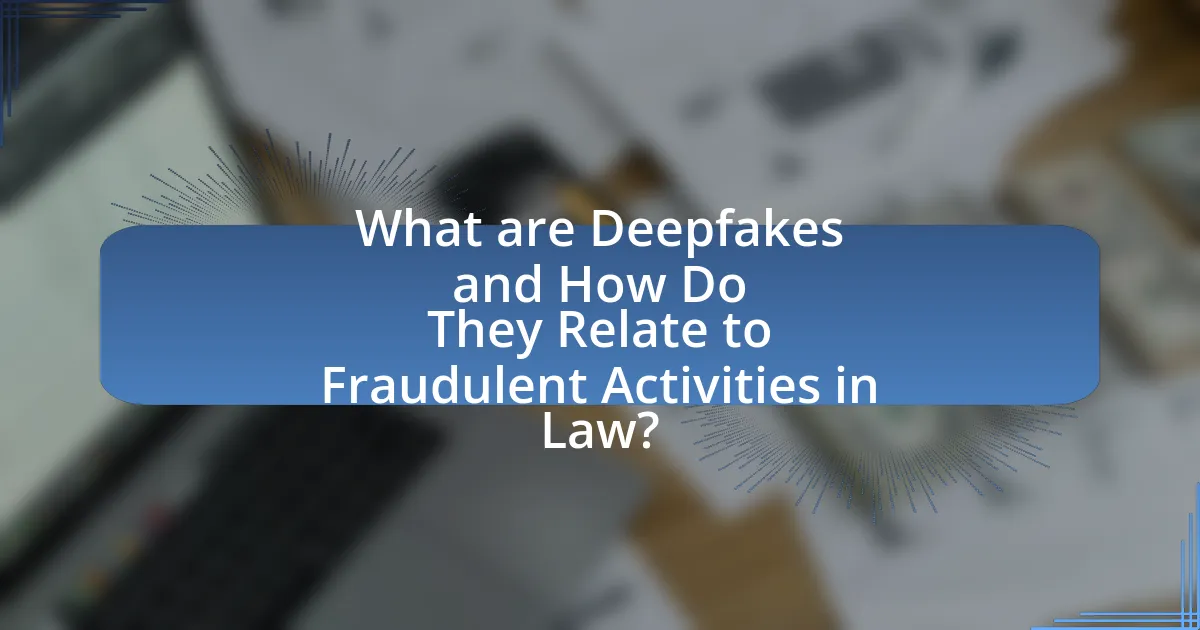
What are Deepfakes and How Do They Relate to Fraudulent Activities in Law?
Deepfakes are synthetic media created using artificial intelligence that can manipulate audio and video to produce realistic but fabricated content. These technologies relate to fraudulent activities in law by enabling the creation of misleading evidence, such as fake videos of individuals making statements they never actually made, which can be used in scams, identity theft, or defamation cases. The potential for deepfakes to distort reality poses significant challenges for legal systems, as they complicate the verification of evidence and can undermine trust in legitimate media.
How are Deepfakes Created and Used in Legal Contexts?
Deepfakes are created using artificial intelligence techniques, particularly deep learning algorithms, which manipulate audio and visual data to produce realistic but fabricated content. In legal contexts, deepfakes can be used as evidence in cases of fraud, defamation, or identity theft, where they may mislead courts or juries by presenting false information as genuine. For instance, a study by the University of California, Berkeley, highlights how deepfakes can be employed to create misleading videos that could influence legal proceedings or public opinion, thereby complicating the judicial process and raising concerns about the authenticity of digital evidence.
What technologies underpin the creation of Deepfakes?
Deepfakes are primarily created using artificial intelligence technologies, specifically deep learning algorithms and generative adversarial networks (GANs). Deep learning enables the analysis and synthesis of large datasets, while GANs consist of two neural networks that compete against each other to produce realistic images or videos. This combination allows for the manipulation of facial features and expressions in a way that can convincingly imitate real individuals. The effectiveness of these technologies is evidenced by their ability to generate high-quality, indistinguishable content, which has raised significant concerns regarding their potential use in fraudulent activities within legal contexts.
How can Deepfakes be manipulated for fraudulent purposes?
Deepfakes can be manipulated for fraudulent purposes by creating realistic but false representations of individuals, which can be used to deceive others for financial gain or reputational damage. For instance, criminals may generate deepfake videos of executives to authorize fraudulent transactions or manipulate public opinion by fabricating statements attributed to political figures. A study by the University of California, Berkeley, highlights that deepfake technology can produce highly convincing content that is difficult to detect, making it a potent tool for fraud. Additionally, the rise of deepfake technology has led to increased concerns among law enforcement and regulatory bodies about its potential misuse in scams and misinformation campaigns.
What Types of Fraudulent Activities Can Deepfakes Facilitate?
Deepfakes can facilitate various types of fraudulent activities, including identity theft, financial fraud, and misinformation campaigns. Identity theft occurs when deepfake technology is used to create realistic impersonations of individuals, enabling criminals to access personal information or commit fraud under false identities. Financial fraud can involve the manipulation of videos or audio to authorize transactions or deceive individuals into transferring money. Misinformation campaigns utilize deepfakes to spread false narratives, potentially influencing public opinion or swaying elections. The potential for these fraudulent activities is underscored by the increasing sophistication of deepfake technology, which has been shown to produce highly convincing content that can easily mislead viewers.
How do Deepfakes contribute to identity theft?
Deepfakes contribute to identity theft by enabling the creation of highly realistic but fabricated videos or audio recordings that impersonate individuals. This technology allows malicious actors to manipulate digital content, making it appear as though a person is saying or doing something they did not actually do. For instance, a study by the University of California, Berkeley, found that deepfake technology can produce convincing impersonations that can be used to deceive victims into revealing personal information or transferring funds. The ability to convincingly mimic someone’s likeness and voice increases the risk of identity theft, as attackers can exploit these deepfakes to gain unauthorized access to sensitive accounts or commit fraud.
What role do Deepfakes play in financial fraud schemes?
Deepfakes play a significant role in financial fraud schemes by enabling the creation of highly convincing fake videos and audio recordings that can impersonate individuals, such as executives or financial authorities. These manipulated media can be used to deceive victims into transferring funds, authorizing transactions, or revealing sensitive information. For instance, a report by the cybersecurity firm Deeptrace indicated that deepfake technology has been increasingly utilized in scams, with a notable rise in cases where fraudsters impersonate CEOs to manipulate employees into executing unauthorized wire transfers. This illustrates how deepfakes can undermine trust and facilitate financial crimes by exploiting the credibility of legitimate figures.
Why is Understanding Deepfakes Important for Legal Professionals?
Understanding deepfakes is crucial for legal professionals because these technologies can significantly impact evidence integrity and legal proceedings. Deepfakes, which are AI-generated synthetic media, can be used to create misleading videos or audio that may falsely implicate individuals in criminal activities or defame them. For instance, a study by the University of California, Berkeley, found that deepfake technology can produce highly realistic content that is difficult to detect, posing challenges for courts in determining the authenticity of evidence. Legal professionals must be equipped to recognize and address the implications of deepfakes to uphold justice and protect the rights of individuals in legal contexts.
What challenges do Deepfakes pose to evidence integrity in court?
Deepfakes significantly challenge evidence integrity in court by creating realistic but fabricated audio and visual content that can mislead juries and judges. The ability of deepfakes to convincingly alter appearances and speech undermines the reliability of video and audio evidence, which has traditionally been considered credible. For instance, a study by the University of California, Berkeley, found that deepfake technology can produce videos that are indistinguishable from real footage, raising concerns about the authenticity of evidence presented in legal proceedings. This manipulation can lead to wrongful convictions or acquittals, as jurors may be unable to discern between genuine and altered content.
How can legal professionals identify and combat Deepfake-related fraud?
Legal professionals can identify and combat Deepfake-related fraud by utilizing advanced detection technologies and implementing strict verification protocols. These professionals should employ AI-based tools that analyze video and audio for inconsistencies, such as unnatural facial movements or mismatched audio-visual synchronization, which are common indicators of Deepfakes. Additionally, legal teams can establish a verification process that includes cross-referencing identities through multiple sources, such as official documents and biometric data, to ensure authenticity.
Research indicates that the use of machine learning algorithms can improve detection rates significantly; for instance, a study published in the journal “Nature” found that certain AI models can detect Deepfakes with over 90% accuracy. By integrating these technologies and protocols into their practices, legal professionals can effectively mitigate the risks associated with Deepfake-related fraud.
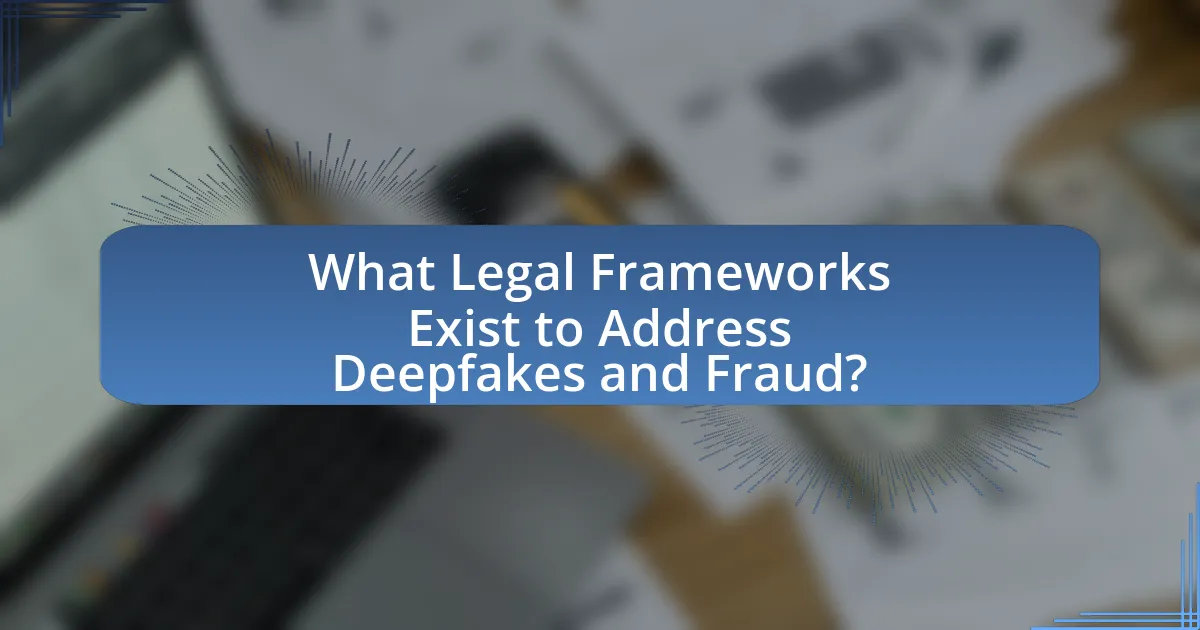
What Legal Frameworks Exist to Address Deepfakes and Fraud?
Legal frameworks addressing deepfakes and fraud include various state laws, federal regulations, and international treaties. In the United States, several states have enacted laws specifically targeting deepfakes, such as California’s AB 730, which prohibits the use of deepfakes to harm or defraud others. Additionally, the Federal Trade Commission (FTC) has guidelines that can apply to deceptive practices involving deepfakes under the Federal Trade Commission Act. Internationally, the European Union’s proposed Digital Services Act aims to regulate harmful content, including deepfakes, while the General Data Protection Regulation (GDPR) addresses privacy concerns related to manipulated media. These frameworks collectively aim to mitigate the risks associated with deepfakes in fraudulent activities.
What Laws Currently Govern the Use of Deepfakes?
Laws governing the use of deepfakes include various state and federal regulations that address issues such as fraud, defamation, and privacy violations. For instance, California’s AB 730 specifically targets the malicious use of deepfakes in elections and prohibits the use of deepfakes to harm or defraud individuals. Additionally, the federal government has proposed legislation like the Malicious Deep Fake Prohibition Act, which aims to criminalize the use of deepfakes for malicious purposes. These laws reflect a growing recognition of the potential for deepfakes to facilitate fraudulent activities, as evidenced by cases where deepfakes have been used to impersonate individuals for financial gain or to spread misinformation.
How do existing laws address the misuse of Deepfakes in fraud?
Existing laws address the misuse of deepfakes in fraud primarily through regulations related to identity theft, fraud, and digital impersonation. For instance, many jurisdictions have enacted laws that criminalize the creation and distribution of deepfakes intended to deceive individuals for financial gain, aligning with statutes against fraud and misrepresentation. In the United States, the Malicious Deep Fake Prohibition Act of 2018 specifically targets the use of deepfakes to harm or defraud individuals, allowing for legal action against offenders. Additionally, various state laws, such as California’s AB 730, impose penalties for using deepfakes to commit fraud or harm others, reinforcing the legal framework against such deceptive practices. These laws serve to deter the misuse of deepfakes by establishing clear legal consequences for fraudulent activities involving this technology.
What are the limitations of current legal frameworks regarding Deepfakes?
Current legal frameworks regarding deepfakes are limited in their ability to address the rapid evolution of technology and the diverse applications of deepfake content. These frameworks often lack specific laws targeting deepfakes, leading to challenges in prosecuting cases of fraud, defamation, and privacy violations. For instance, existing laws may not adequately cover the nuances of consent and authenticity required in deepfake scenarios, resulting in legal ambiguities. Additionally, the jurisdictional issues complicate enforcement, as deepfake content can be created and distributed across multiple regions, often outpacing legislative responses. This gap in legal coverage allows malicious actors to exploit deepfake technology for fraudulent activities without facing significant legal repercussions.
How Are Courts Responding to Cases Involving Deepfakes?
Courts are increasingly recognizing the legal challenges posed by deepfakes, responding with a mix of existing laws and new legislative measures. For instance, some jurisdictions have begun to apply fraud and defamation laws to cases involving deepfakes, holding individuals accountable for creating or distributing misleading content that harms others. In 2021, California enacted a law specifically targeting deepfake technology, making it illegal to use deepfakes to harm or defraud individuals, particularly in the context of elections and pornography. This legislative action reflects a growing awareness of the potential for deepfakes to facilitate fraudulent activities, prompting courts to adapt their approaches to ensure justice and accountability.
What precedents have been set in legal cases involving Deepfakes?
Legal cases involving deepfakes have established precedents primarily around issues of defamation, privacy invasion, and intellectual property rights. For instance, in the case of “Doe v. Heller,” the court recognized that deepfake technology could be used to harm individuals’ reputations, setting a precedent for defamation claims. Additionally, the “California AB 730” law, enacted in 2019, specifically addresses the use of deepfakes in a manner that can deceive or defraud, reinforcing legal accountability for malicious uses of this technology. These cases and legislative actions illustrate the evolving legal landscape as courts and lawmakers respond to the challenges posed by deepfakes in fraudulent activities.
How are judges and juries being educated about Deepfakes?
Judges and juries are being educated about deepfakes through specialized training programs and resources provided by legal organizations and technology experts. These educational initiatives include workshops, seminars, and online courses that focus on the identification and implications of deepfake technology in legal contexts. For instance, the National Center for State Courts has developed materials that explain the technical aspects of deepfakes and their potential impact on evidence and testimony. Additionally, legal professionals are encouraged to stay updated on advancements in digital forensics, which can aid in detecting manipulated media. This structured approach ensures that judges and juries are equipped with the necessary knowledge to assess the authenticity of evidence in cases involving deepfakes.
What Future Legal Developments Can We Expect Regarding Deepfakes?
Future legal developments regarding deepfakes are likely to include the establishment of specific regulations and laws aimed at addressing their misuse in fraudulent activities. As deepfake technology evolves, jurisdictions are increasingly recognizing the potential for harm, leading to legislative proposals that target the creation and distribution of deceptive content. For instance, California enacted a law in 2018 that criminalizes the use of deepfakes for malicious purposes, such as defamation or fraud, indicating a trend toward more comprehensive legal frameworks. Additionally, the Federal Trade Commission has begun to explore guidelines that could regulate the use of deepfakes in advertising and media, reflecting a growing concern over consumer protection. These developments suggest a future where legal systems will adapt to the challenges posed by deepfakes, aiming to mitigate their impact on society and uphold accountability for fraudulent actions.
How might legislation evolve to better address Deepfake technology?
Legislation may evolve to better address Deepfake technology by implementing stricter regulations that define and penalize the creation and distribution of malicious deepfakes. Current laws often lack specificity regarding digital content manipulation, leading to challenges in prosecuting offenders. For instance, the Malicious Deep Fake Prohibition Act introduced in the U.S. Congress aims to criminalize the use of deepfakes for harassment, fraud, or other harmful purposes, reflecting a growing recognition of the technology’s potential for misuse. Additionally, incorporating requirements for digital watermarking and transparency in AI-generated content could enhance accountability and help identify deceptive materials, as seen in proposals from various tech policy think tanks. These legislative advancements are essential to protect individuals and society from the risks associated with deepfake technology.
What role will technology play in shaping future legal responses to Deepfakes?
Technology will play a crucial role in shaping future legal responses to deepfakes by enabling the development of advanced detection tools and regulatory frameworks. These detection tools, such as AI algorithms and machine learning models, can identify manipulated media with increasing accuracy, thereby assisting law enforcement and legal entities in addressing fraudulent activities. For instance, a study by the University of California, Berkeley, demonstrated that AI can achieve over 90% accuracy in detecting deepfake videos, highlighting the potential for technology to support legal measures. Furthermore, technology will facilitate the creation of legal standards and guidelines that govern the use of deepfakes, ensuring accountability and protecting individuals from harm.

What Best Practices Can Be Implemented to Mitigate Deepfake Fraud?
To mitigate deepfake fraud, organizations should implement a combination of technological solutions, user education, and regulatory measures. Technological solutions include the use of deepfake detection software, which employs machine learning algorithms to identify manipulated media. For instance, a study by the University of California, Berkeley, demonstrated that AI-based detection tools can achieve over 90% accuracy in identifying deepfakes. User education is crucial; training individuals to recognize signs of deepfake content can reduce susceptibility to fraud. Additionally, regulatory measures, such as establishing legal frameworks that penalize the creation and distribution of malicious deepfakes, can deter potential offenders. These best practices collectively enhance the ability to combat deepfake fraud effectively.
How Can Organizations Protect Themselves from Deepfake Fraud?
Organizations can protect themselves from deepfake fraud by implementing advanced detection technologies and training employees to recognize potential deepfake content. Utilizing AI-based tools that analyze video and audio for inconsistencies can help identify manipulated media. For instance, a study by the University of California, Berkeley, demonstrated that machine learning algorithms can detect deepfakes with over 90% accuracy. Additionally, educating staff about the characteristics of deepfakes, such as unnatural facial movements or audio mismatches, enhances vigilance against fraudulent attempts. Regularly updating security protocols and collaborating with cybersecurity experts further fortifies defenses against evolving deepfake techniques.
What preventive measures can be taken to detect Deepfakes early?
Preventive measures to detect Deepfakes early include the implementation of advanced detection algorithms and the establishment of digital content verification standards. Advanced detection algorithms utilize machine learning techniques to analyze inconsistencies in video and audio data, identifying artifacts that are often present in manipulated content. For instance, a study by the University of California, Berkeley, demonstrated that deep learning models could achieve over 90% accuracy in identifying Deepfakes by analyzing facial movements and inconsistencies in lighting. Additionally, establishing digital content verification standards, such as blockchain technology for content provenance, can help ensure the authenticity of media before it is disseminated. These measures are crucial in combating the potential misuse of Deepfakes in fraudulent activities within legal contexts.
How can training and awareness programs help in combating Deepfake fraud?
Training and awareness programs can significantly combat Deepfake fraud by educating individuals about the technology and its potential misuse. These programs enhance the ability of users to recognize Deepfake content, thereby reducing the likelihood of falling victim to scams or misinformation. For instance, a study by the University of California, Berkeley, found that individuals who underwent training on identifying manipulated media were 70% more likely to detect Deepfakes compared to those who did not receive such training. This increased awareness not only empowers individuals but also fosters a more informed public that can critically evaluate digital content, ultimately mitigating the risks associated with Deepfake fraud.
What Resources Are Available for Legal Professionals Dealing with Deepfakes?
Legal professionals dealing with deepfakes can access a variety of resources, including legal databases, specialized training programs, and technological tools. Legal databases such as Westlaw and LexisNexis provide case law and statutes relevant to deepfake-related issues, while organizations like the American Bar Association offer training and guidelines on the legal implications of deepfakes. Additionally, technological tools such as deepfake detection software can assist legal professionals in identifying manipulated media, enhancing their ability to address fraudulent activities effectively. These resources are essential for navigating the complexities of deepfakes in legal contexts.
What tools can assist in the detection of Deepfakes?
Tools that can assist in the detection of Deepfakes include Deepware Scanner, Sensity AI, and Microsoft Video Authenticator. Deepware Scanner utilizes machine learning algorithms to analyze videos for signs of manipulation, while Sensity AI employs a combination of computer vision and deep learning techniques to identify altered media. Microsoft Video Authenticator assesses images and videos to provide a confidence score regarding their authenticity. These tools have been developed in response to the increasing prevalence of Deepfakes, which pose significant risks in legal contexts, such as fraud and misinformation.
How can legal professionals stay updated on Deepfake technology and legislation?
Legal professionals can stay updated on Deepfake technology and legislation by regularly engaging with specialized legal journals, attending relevant conferences, and participating in online forums focused on technology law. Legal journals such as the Harvard Law Review and the Stanford Technology Law Review frequently publish articles on emerging technologies, including Deepfakes, providing insights into current legal challenges and legislative developments. Conferences like the International Conference on Cyberlaw, Cybercrime & Cybersecurity offer networking opportunities and expert discussions on the implications of Deepfake technology in law. Additionally, online platforms such as LinkedIn and legal tech blogs provide real-time updates and discussions among professionals, ensuring that legal practitioners remain informed about the evolving landscape of Deepfake legislation and its impact on fraudulent activities.
What Practical Steps Can Individuals Take to Safeguard Against Deepfake Fraud?
Individuals can safeguard against deepfake fraud by verifying the authenticity of digital content before trusting or sharing it. This can be achieved through several practical steps:
- Utilize reverse image search tools to check the origin of images and videos.
- Pay attention to inconsistencies in audio and visual elements, such as unnatural facial movements or mismatched lip-syncing.
- Rely on reputable news sources and fact-checking websites to confirm the validity of suspicious content.
- Educate oneself about the technology behind deepfakes and stay informed about the latest developments in detection methods.
- Use software tools designed to detect deepfakes, which analyze digital content for signs of manipulation.
These steps are essential as deepfake technology has advanced significantly, with a 2020 report from Deeptrace indicating a 100% increase in deepfake videos online, highlighting the urgent need for vigilance.
